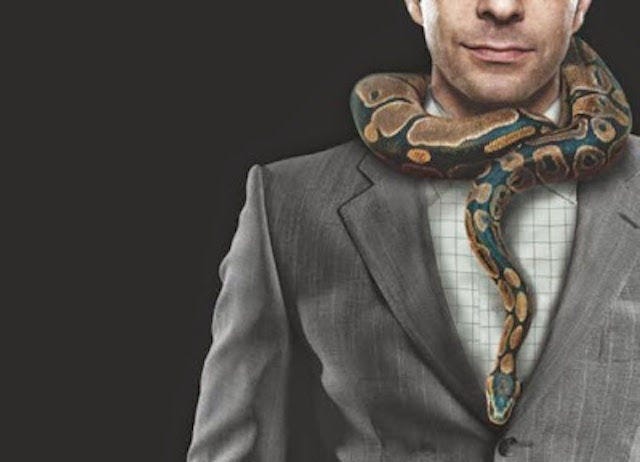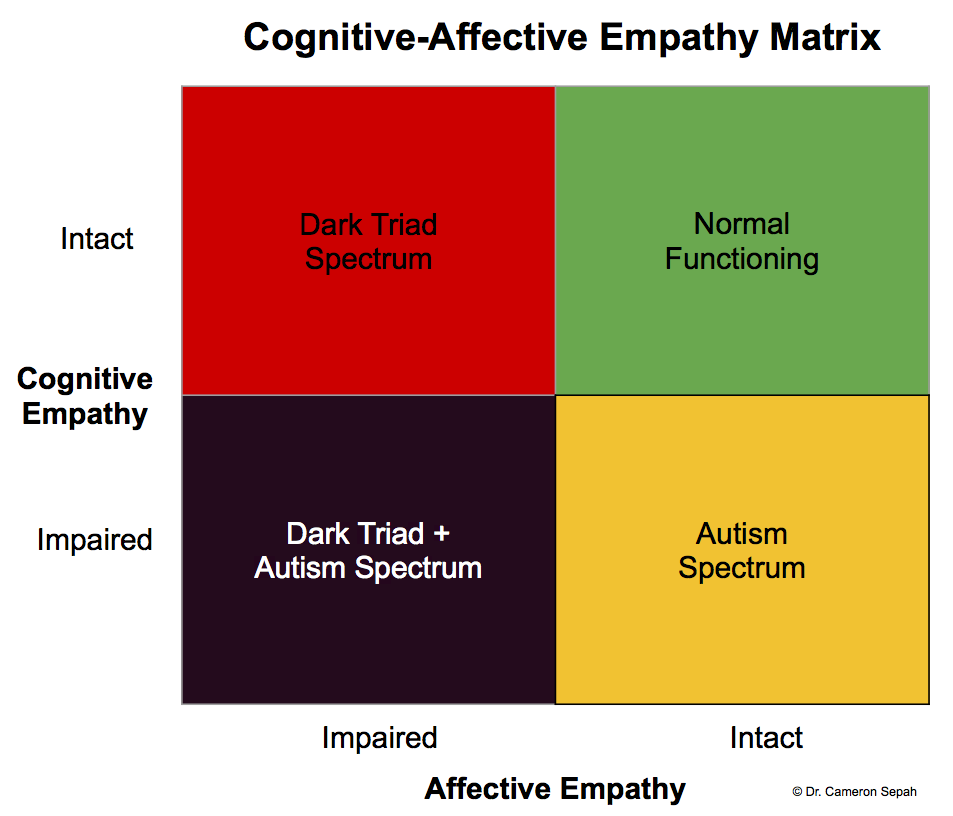In Part 1, The Performance-Values Matrix, I argued that the biggest reason company cultures degrade is they hire, retain, and promote “assholes” (mercenary employees whose lack of empathy causes interpersonal issues). I also introduced the Performance-Values Matrix as a reinforcement system address this problem. Let’s now dive deeper into clinical understanding of this behavior and how it can be carefully managed in a corporation.
Part I: Anatomy of an Asshole (The Dark Triad)
“Asshole” is not a term I use clinically/scientifically, but people use it commonly because it provides a shared understanding of something you “know when you see it.” So my goal here is to clearly categorize a pattern that you probably intuitively recognize, in a way that’s more insightful.
Clinically, there are three distinct types of socially aversive personalities, known as the “Dark Triad”: psychopathy, narcissism, and Machiavellianism. These traits are dimensional in a sense that all of us fall somewhere on the spectrum, but only those who are very high in the trait can be considered diagnosable with a full-blown personality disorder. If you’re curious, you can take the online Short Dark Triadpersonality test to see at what percentile you exhibit these three traits, compared to the general population.
The key to understanding the Dark Triad is that while all three share a callousness toward others that encourages manipulativeness, they do so for distinct reasons. Psychopaths are driven by short-term tangible rewards, and engage in reckless, antisocial behavior to get it. Machiavellians are fueled by long-term tangible rewards and will strategize schemes to get them. Narcissists are motivated by whatever boosts their ego, whether tangible rewards or simple praise that validates their idealized self-image.
Psychopathy, a.k.a. The Gordon Gekko
Also known as sociopaths, or antisocial personalities, psychopaths are your typical movie villains. Their emotionality is callous and aggressive (manifested as angry outbursts or even physical violence with little remorse) and their behavior is impulsive and irresponsible (often blatantly disregarding the safety of themselves or others). They gleefully defy norms and laws, and use deceit and manipulation for profit or (even creepier) self-amusement.
Though only 1–2 percent of people in the general population can be clinically diagnosable as having “antisocial personality disorder” (in the DSM-5, the manual for psychiatric illnesses), they are unfortunately overrepresented in corporations, especially among CEOs. Favorite cinematic depictions of psychopaths in corporations are Gordon Gekko in “Wall Street” and Patrick Bateman in “American Psycho”.
A unique aspect to psychopaths is they tend to have a short-term focus: for example, they will lie for immediate gratification, even if those lies compromise their long-term gains. Other short-term behavior such as recklessness and thrill-seeking tends to drive ambitious and reckless criminal behavior. For further reading, I recommend the book, Snakes in Suits: When Psychopaths Go to Work.
Machiavellianism, a.k.a. The Frank Underwood
The Machiavellian is a strategic, calculating manipulator who believes that the ends justify any means. While as manipulative as psychopaths, Machiavellians are far more future-oriented: planning ahead, forming alliances, and carefully maintaining their reputations. They tend to achieve the latter by shielding close friends and family members from their nefarious ways.
Unlike psychopathy, which is more genetic and rarely remediable, machiavellianism can be more of a fluid “state” than a permanent personality “trait”. As the Milgram and Stanford Prison experiments suggested, normally prosocial people can act surprisingly Machiavellian when put into the right situation. In fact, I have seen corporate leaders who appear to be genuinely kind in their personal lives, act surprisingly Machiavellian when their companies are put into difficult financial dilemmas (e.g. hiring and refusing to fire mercenary employees). Corporate culture, particularly in Silicon Valley, encourages such behavior by glorifying the leaders that “do whatever it takes” to ensure their company survives and succeeds.
The irony is that startups say they love “hustlers” (i.e. proactive employees that do whatever it takes to get the job done), though the term hustler also means someone who cons and cheats others. Coincidence? Probably not. For further reading, I recommend the classic books Machiavelli’s The Prince and Sun Tzu’s The Art of War, and for a more modern rendition, Robert Greene’s The 48 Laws of Power.
Narcissism, a.k.a. The Tony Stark
Most people are familiar with the most obvious features of narcissism: grandiose self-confidence and self-centeredness, which comes off as smug and self-serving. However, the narcissist is actually insecure inside and is on a never-ending quest for ego-reinforcement, including going so far as to deceive himself. Narcissists seem to believe their own boasts and feel entitled, even when it can be verified that they are exaggerating their competence.
Emotionally, narcissists feel anger and aggression if their fragile ego is threatened (known as “narcissistic rage”). Given they cannot be vulnerable enough for true intimacy, their relationships tend to be unempathic and superficial. Behaviorally, they tend to act antagonistically towards others — manipulating, lying, and threatening to get their way — and engaging in uninhibited acts that are irresponsible, impulsive, or risky to seem exciting or daring.
It is important to note that some degree of ego is actually healthy to form a resilient sense of self that allows one to persevere through trying times. The distinction is that healthy self-confidence is an attitude based on mastered accomplishments, adhered values, and respect toward oneself and others, while narcissistic self-confidence is actually a psychological defense against underlying inadequacy (which is why it’s referred to as “malignant self-love”).
At some point in their lives, about 6 percent of people will meet full criteria for narcissistic personality disorder, with more men (8 percent) than women (5 percent) qualifying. As with the rest of the Dark Triad, narcissists are overrepresented among leaders — especially leaders of nations. For a psychoanalytic perspective on how narcissism develops, I recommend the book, The Drama of the Gifted Child.
Part II: The Accidental Asshole (High-Functioning Autism)
Distinct from the Dark Triad spectrum is a condition that can actually be useful for work called Autism Spectrum Disorder, in which high-functioning cases, were formerly known as Asperger’s. People on the autism spectrum are not usually assholes. But they share an impaired sense of empathy that can make them superficially seem like assholes.
The key distinction is that people with Dark Triad traits are often insensitive to others, while people with autism can be indifferent. They have difficulty picking up on cues that would prompt them do or say what’s considered socially appropriate. One of the best showcases of this distinction is in the movie, “The Social Network.” To be clear: I am not diagnosing Mark Zuckerberg (who was my Harvard classmate and a nice guy), but am discussing the fictional movie character in line with the rest of his post.
The film starts with Mark and Erica going out on a date, and results in her breaking up with him because he says offensive things, which she interprets as him being asshole (i.e. Dark Triad spectrum). However, by the ending scene, Marilyn, Mark’s attorney, recognizes that he is not actually an asshole, but that he’s more painfully oblivious (i.e. autism spectrum) and is trying to mimic the hard-nosed behavior of what he believes other CEOs do.
Opening scene [Erica]: “You are probably going to be a very successful computer person. But you’re going to go through life thinking that girls don’t like you because you’re a nerd. And I want you to know, from the bottom of my heart, that that won’t be true. It’ll be because you’re an asshole.”
Ending scene [Marilyn]: “You’re not an asshole, Mark. You’re just trying so hard to be.”
Cognitive vs. Affective Empathy
Most people think of empathy simply as understanding others (or confuse it for sympathy). But psychologists distinguish between two main types of empathy: cognitive and affective. Cognitive empathy is the capacity to understand another person’s mental state, while affective empathy is the capacity to respond with an appropriate emotion to another person’s mental state.
For example, if you see someone fall and rip their jeans, experiencing cognitive empathy would be to place yourself in their shoes and realize the other person would likely be thinking “How embarrassing!” But affective empathy would be to actually experience feeling embarrassed for them along with feeling a compassionate desire to help them.
As seen in the matrix below, people on the autism spectrum have impaired cognitive empathy and intact affective empathy, while people on the dark triad spectrum have the reverse: intact cognitive empathy and impaired affective empathy. Thus, people on the autism spectrum have interpersonal difficulties because they have difficulty understanding social situations, while people on the dark triad spectrum understand social situations well but often have antisocial objectives. So while people on the autism spectrum are asocial, while people on on the dark triad spectrum are antisocial. It is also possible to have both autism and dark triad spectrum traits, and thus feel little cognitive or affective empathy.
Unempathic Partners in Crime
It would seem that people with Dark Triad and autism spectrum traits would not likely be friends, given that people with Dark Triad traits can often be (superficially) charming, while those on the autism spectrum often have trouble fitting in socially. But these individuals often become partners in crime because their respective deficits in empathy allows them to complimentarily work together in a strangely parasitic symbiosis. This metaphor is useful in understanding how their motivations differ at work:
“[People on the autism spectrum are] focused on ‘building a better box’; on the box itself, on how it’s made, on improving it, on what else it can be used for, on other boxes like it, and often wants others to hear about the box and their ideas, share in their enthusiasm, or at least be understanding or respectful of their enthusiasm about ‘the box’.
[In contrast, people on the Dark Triad spectrum are] focused on getting credit for ‘building a better box’ (whether they built it or not), getting seen as the ‘box-builder’, getting credit for being the Most Expert Box Builder, how the box can be used to make themselves money or to further their personal agendas, how to hide the fact that someone else built the box.”
My favorite movie portrayal of this dynamic is from the 2013 biopic, Jobs. In a dramatic scene, Steve Jobs convinces his friend Steve Wozniak to help him design a new video game for Atari, but lies to him by offering to split a $700 bonus (which was really $5,000). Years later, Wozniak found out about Jobs’ duplicity while reading a book on Atari’s history and was brought to tears.
Thus, people with Dark Triad traits tend to prey on people on the autism spectrum and use them as “sidekicks” to exploit their loyalty and talent. However, when the person on the autism spectrum figures out what happened, the Dark Triad person often turns on them with a vengeance in order to avoid being exposed. For example, a manager can influence an analyst to produce promising but questionable data to push their own agenda, which later results in a falling out between the two (often after the damage is irreversibly done).
Part III: Managing the Darkness Within
Even if they are competent, people who strongly exhibit Dark Triad traits at work need to be remediated or separated in order to maintain the company’s culture. However, if they stay, it is critical to recognize the degree to which they are socially and occupationally impairing, and take swift steps to mitigate damage when social dynamics become disrupted or exploitative. In my experience, Dark Triad employees work best at values-congruent companies if they are in niche roles that accentuate their strengths and minimize their weaknesses.
They often work better as individual contributors, given that empathy is a key aspect of being a successful manager, and the perception that your manager genuinely cares about your well-being is one of the strongest predictors of employee job satisfaction. Thus, individuals who strongly exhibit these traits and have to interact regularly with others often need to be specially managed in order to ensure their success and the well-being of those around them. Using the Performance-Values Matrix described in Part 1is a key management structure to reinforce prosocial behavior and punish antisocial behavior.
It’s important to note that there are exceptional CEOs with these traits that are still wildly successful and admired. In the potential case of Steve Jobs, he was also an incredibly talented visionary with a complimentary talented team. Being surrounded by operational leaders with high emotional intelligence (EQ) can help balance the high IQs (and temperaments) of visionary CEOs and steadily steer unicorn companies forward.
In case you take such success as an excuse to flaunt your darker traits as a leader, just remember: you are not Steve Jobs. Unlike a renaissance prince, as a CEO, it is much better to be loved than feared. Effective leaders must embody the light by understanding and managing the darker traits of their employees.
How have you seen these traits play out at work? Please share your stories and feedback in the comments below.
Continued in Part 3: Breaking Bad: Why Good People Become Evil Bosses
If you like what you read, sign up for my newsletter, and follow me on Medium, LinkedIn, & Twitter.
Thanks to Ella Chiang, Nicole Zeman, and RJ Ellis for input on this post.






